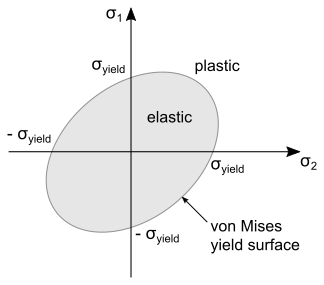Elastoplastic Materials
Plasticity refers to the permanent, irreversible, deformation of a solid material. Elastoplastic materials are materials that exhibit linear elastic behavior for sufficiently small stresses, and plastic behavior for higher stresses. The stress at which the material begins to deform plastically is called the yield stress. The stress-strain relationship for elastoplastic materials is linear below the yield stress, and nonlinear above the yield stress.
The following formulation is valid for small strains and assumes that the plastic deformation is independent of the rate at which the deformation occurs.
For small strains, the strain tensor can be written as:
where is the elastic strain tensor, is the plastic strain tensor, and includes any inelastic contribution to the strain tensor (for example, the thermal strain).
Following Eqn. (4503), the stress tensor can then be written as:
where is the material tangent. The energy that is dissipated due to plastic deformation can be written as:
where is the Cauchy stress tensor.
A scalar measure of the plastic strain is the equivalent, or accumulated, plastic strain . This quantity represents the incremental plastic strain that is accumulated as the plastic damage increases:
Another scalar measure of plastic strain is the effective plastic strain , defined as:
To describe the stress-strain curve of elastoplastic materials, it is possible to define a function, called the plastic potential, such that:

From Eqn. (4520), any stress state within the yield surface is elastic; any stress outside the yield surface is plastic. In general, the yield surface has the form:
where is some measure of stress and is the material yield stress. For metals, the most common plastic potential is the J2 potential (also known as the von Mises potential), which is defined as:
Hardening Models
Hardening models describe how the yield surface changes with subsequent yielding. For example, for isotropic hardening, the yield surface remains centered about the same location, while expanding in size.
Simcenter STAR-CCM+ provides standard models for linear isotropic hardening and saturation hardening, as well as a user-defined hardening model.
- Linear Isotropic Hardening
-
This model defines the yield stress as a linear function of the equivalent plastic strain :
(4523)where is the initial yield stress and is the hardening tangent that defines the slope of the linear function.
For , the yield stress is constant (). This type of behavior is known as perfectly plastic.
- Saturation Hardening
-
This model defines the yield stress as a nonlinear function of :
(4524)where , , , and are parameters that can be found by curve-fitting material test data. The curve given by Eqn. (4524) approaches an asymptotic limit at higher strains:
- User-Defined
- This model allows you to capture the material
behavior from experimental data. To define the stress-strain relationship,
you specify the nominal stress
and its derivative with respect to the
nominal strain
:(4525)The nominal strain and nominal stress express the respective quantities in the undeformed configuration:(4526)(4527)These nominal measures deviate from the true stress and strain values for large deformations, therefore, this model is suited to applications with small deformations.